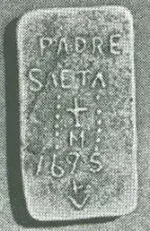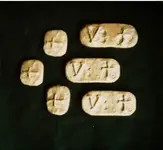Dear gollum;
You wrote:
Lamar,
First, Chuck Kenworthy never claimed to be any kind of a font of Jesuit Knowledge. He was a treasure hunter plain and simple. He became a millionaire in the 1970s in Southern California in Real Estate. He was working on two or three treasure projects at the time of his death, and one that he hadn't been able to spend as much time as he would have liked was a Jesuit Treasure, but he never claimed to have any intimate knowledge of Jesuit matters.
As a matter of fact, the entire subject of treasure hunting is a very sore one with the family, as most of his kids feel that Chuck abandoned them in favor of hunting lost fortunes.
Also, Chuck is the one who recovered those 1028 Silver Bars from Father Javier Saeta's Martyr Cache
Joe,
I have a friend who was very close to Chuck. About a month or so before he died, Chuck showed up at my friend's office with some large boxes of research materials (marked up topos, marked up pictures, etc). My friend was out of town on business, and by the time he returned, Chuck had passed away. He was supposed to have received after Chuck's passing all the copies of the Archive Materials that Chuck based his books on. One person stepped in at the last minute and nixed that.
I will explain my best guess as to why those documents are still kept hidden. Chuck spent a LOT of money bribing Archivists in Mexico, Rome, Seville, and anywhere else he thought might contain the knowledge he was searching for. The information he released was just a drop in the bucket of the knowledge he possessed. Now, that knowledge belongs to someone else in his family. What is being done with it, I can't say. I will say that myself, and people who were close with Chuck Kenworthy NEVER doubt for a second that those documents exist.
I also know that most of the Dutch Hunters never put much stock in any of Kenworthy's ideas about monuments, markers, and the like, but you could fill a thimble with all the gold those experts have found in all their years in the Supers. I will PM you a little something that's not really for posting.
Best-Mike
I would like to ask that we stop and think about portions of your statement logically for just a moment, my friend. I was fortunate enough to have actually read a couple of chapters of one of Mr. Kenworthy's books, Unfound treasures of Mexico, I think it was. Within the few pages that I took the time to read, I found mistake after mistake, and not just mistakes, but glaringly obvious ones at that. Please allow me to provide but one small example from the book. And now an excerpt from the book "Unfound Treasures of Mexico".
Toward the end of the 1500's, New Mexico was colonized by the Spanish. It was in Santa Fe that the palace of governors was completed in 1609. This palace was to govern Northern Mexico; Which Was A Considerable Portion Of United States Today.
Adjoining the Palace of Governors, the San Miguel Cathedral was constructed and in operation in 1636.
This was the central point for the church not only in seeking converts, but to help solve the major problems developing in the palace of governors. It seems that the Christianized miners rebelled if they did not have a fray/padre with them to hear their last confession or give them the last rites at the distant mining operation (and there were many deaths). So, it worked good for both Spain and the church.
First, there is no San Miguel Cathedral in Santa Fe New Mexico, my friend, however there is a San Miguel Mission Chapel, which can in no way be misconstrued for a cathedral, nor is it on the plaza. The chapel was a part of the San Miguel Franciscan Mission, but it's not next to the Governor's Palace. Also, it was not completed in 1636, rather it was was completed in 1610 and is, as a point of fact is, reputed to be the oldest continually standing and occupied church building in the USA. I think that Mr. Kenworthy somehow confused the San Miguel Chapel with the original La Parroquia church, which was also built in 1610 and destroyed by a native American uprising in 1680. Thenceforth a new La Parroquia church was constructed and later, a cathedral was actually built all around the still standing and in use church. Once the cathedral was completed in 1714, the church was torn down from INSIDE of the cathedral and removed piece by painstaking piece through the doors of the newly completed cathedral. The name of the cathedral was called The St. Francis cathedral, after the patron saint of the Franciscans which settled Santa Fe and converted the natives. This same cathedral, which was proclaimed a Basilica in 2005 by Pope Benedict XVI, is now called the Cathedral Basilica of St. Francis of Assisi.
Next, there was at no time a Roman Catholic church built next to the Governor's Palace in Santa Fe, New Mexico, and I'll tell you why. Because the Governor's Palace is on the North side of the plaza and the Cathedral Basilica of St. Francis is on the East side, and there is a very good reason for this. It's because Roman Catholics traditionally pray and celebrate Mass facing to the East, which of course is the direction of the rising Sun. If a church is built facing the West, the altar and tabernacle will be facing East and it is the Eastern wall which the traditional celebrants face. If you visit any older town where there was an early Roman Catholic influence, such as the Southwestern US, Mexico, Central or South America you will discover that the layout of the central plaza is always the same. The church is always on the Eastern side of the plaza with it's main doors facing to the West and the altar and congregation facing the East.
Please note that with the more modern Roman Catholic churches this is no longer a requirement, rather it's more of a preferred option, for lack of a better way to put it. I however, still face the East and I only attend Mass in churches which are oriented in the correct direction, in case you were wondering about it.
Now, let's think about all of this logically. An author, who lived one state away from New Mexico could not seem to get his facts straight whereas someone living in Bolivia can. What's wrong with this picture, my friend? It should be immediately obvious that the man knew next to nothing of traditional Roman Catholics in general, yet he somehow learned all about the inner workings of the early Franciscan and Jesuit missionaries? He couldn't even provide the reader with the correct name of a church nor could he provide the correct date of construction, nor even the correct location of said cathedral. Seeing as how cathedrals are usually fairly oppulant in size and weight, they most generally tend to stay in one place for their entire lifespan, therefore I seriously doubt the cathedral moved at all since it was constructed, especially going as far as taking a stroll across the plaza to it's present location.
Also, as a point of fact, the Spanish contained in Mr. Kenworthy's book is lacking, to put it politely. He used a form of Spanglish which no respectable Spanish or Mexican scribe would have used. Of course this fact leads me to believe that *if* Mr. Kenworthy actually had access to the archives of Mexico and Seville that he would not have been able to translate them with any amount of accuracy, if at all.
I also seriously doubt that Mr. Kenworthy could have bribed his way into the Vatican archives or managed to have copies of any documents smuggled out. First, the Roman Catholic church is a very large group and as such, it has sizeable holdings, therefore bribery will not work with a cleric of the Vatican. Not even a sizeable donation would have gotten the donor into the archives nor would it have gotten copies of any documents out. Please remember that the Vatican archives are not a public library and as such they have always maintain very strict controls of all of it's documents. In fact, until very recently, only three priests would be assigned to work in the Archives at any one time and always as librarians. Besides, why try to bribe your way past the front door of the Vaatican archives when can do the same research, only about a billion times faster, while sitting in comfortable chairs, with central heat and AC in St. Louis, Mo.? The reason why Mr. Kenworthy never mentioned this fact is most likely because he was not aware of it, as most people are not. For some odd reason, people still tend to think that the Vatican archives house all the deep, dark secrets of the Universe, whereas the truth of the matter is that most of the revelant information from the Vatican Archives can be accessed by virtually anyone.
Also, and this holds true even today, the archives remain vastly uncataloged, that is to say that unless a person knows exactly the document they are searching for and what it is in reference to, they will not get to view said document, simply because the librarians do not know where the document has been filed inside of the archives as the archives have some fifty-two MILES of shelves, my friend. I find it difficult to believe that a man could navigate his way through any archive, be it Spanish, Mexican or Vatican if he were unable to accurately state the history of a particular Roman Catholic church in a country where he's resided his entire life.
The mistakes I've noted in his books are practically without end and in light of this, I've concluded that the man either did very shoddy research, if any at all, or he made up entire blocks of history as he went along.
Your friend;
LAMAR





